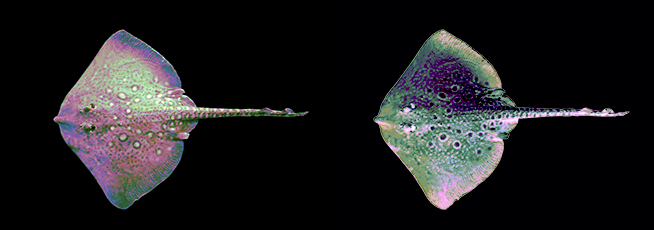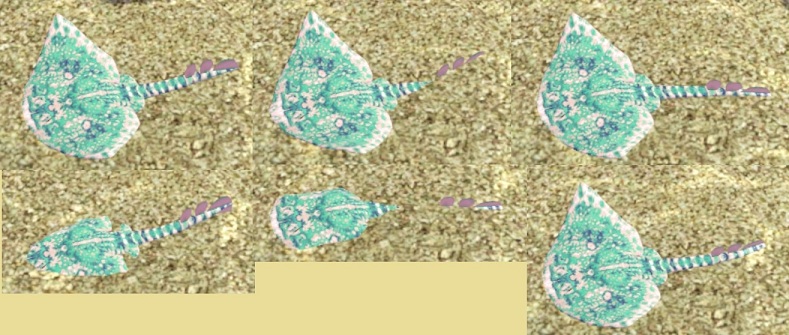In fall of 2013, a diver reported sighting a ray or skate in Sim waters, describing it as "creepy" with apparent mobility problems. However, the account was initially dismissed as an aberration or "glitch" due to the nature of the publication. The same species was re-discovered in November by Mouse of MTS, also with the observation that the animal appeared to be in distress and unable to free itself from the benthic sediment.
Mouse was able to identify the animal as the Thornback "ray" Raja clavata, largely on the basis of dorsal patterning. R. clavata is a bottom-dwelling elasmobranch that is color-adapted to its environment, ordinarily with earth-tones on the dorsal side and white underneath. Compared to their Atlantic counterparts, the specimens sighted and photographed in Sim waters have similar patterning, but more vibrant coloration.

Raja clavata, Atlantic specimen with computer-processed coloration
(photo: Hans Hillewaert; false colour: R. De Noube/SVNL)
Their egglaying mode of reproduction and absence of a barbed tail place Thornbacks in the family of skates, not rays. (Rather than irritate adherents of one name or the other, we will usually refer to the animals simply as "Thornbacks", or else by their species name.) In common with all skates and many rays, R. clavata has a benthic (bottom-resting) habit but is capable of excursions into open water (benthopelagic behavior).
Many of the specimens observed by Mouse, however, evidenced a movement disorder. In a typical observation the animal, although using pectoral-disk ("wing") motions appropriate to swimming in the water of the demersal zone, would fail to dislodge itself from the sand or silt. The team at MTS hypothesized that the Thornbacks were lacking a neuromuscular capability required for three-dimensional motion; skates, unlike pelagic fish, are negatively bouyant and must maintain altitude above the sea bed by voluntary effort. A major goal of current research is to understand the normal life-cycle of Sim Thornbacks and, so far as possible, to restore their motility and their place in the marine ecosystem.

